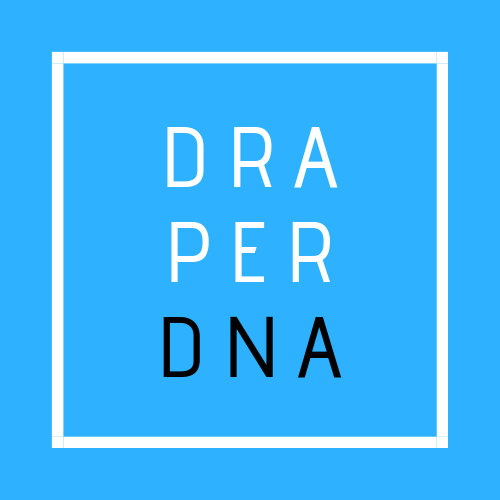There is a Difference featuring Rick Binger
August 30, 2021
We spoke with Draper DNA creative director, Rick Binger, about how to surprise and delight through imaginative thinking and disruptive ideas. He shares insights to how he makes a difference in meaningful creative campaigns.
Rick: I am Rick Binger, the principal and creative director of Ideya, who specializes in branding, advertising, and design.
Your work with John Deere government really spoke to Draper DNA when partnering with you, tell us about how that campaign made a difference.
Rick: The John Deere campaign was loads of fun and that’s really what made a difference. Within the world of government procurement, it can be a bit dry or a bit stale, as you can imagine. Our mission going into this was to do something completely the opposite of that. We knew our key message was “easy procurement” for federal, state, and local governments. And John Deere accomplishes that with special contracts, which reduces paperwork, and makes it easier to get the tractor or the mower that you need. That reduction in paperwork was really our key insight. Once we knew that, we knew what we were going to do.
We created these landscapes that were filled to the brim of paperwork, and we showed John Deere products removing that paperwork. It could be a tractor pulling a cutter…a roadside mower shredding paperwork and reams of paper and revealing the grass underneath. Or it could be a snowblower blowing it off the sidewalk. The campaign had really long legs, meaning that there are so many John Deere products, we could show them eliminating or reducing paperwork in so many different ways. It was a fun campaign to work on and it really stood out in the sea of sameness within the bureaucratic or government world.



There were a lot of ingredients for success for this one — we had a sound strategy to begin with. We had a big idea. We had really good production values — specifically in terms of the retouching and the CGI work involved — to create these environments. We also had a brave client with the courage to do something new and novel and different. This campaign was first created seven years ago, and it ran for five years in many different mediums. From print ads to digital ads, email campaigns, calendars, direct mail. It was a big success and lots of fun.
Where does the creative process begin for you after you’ve read the creative brief for a new campaign?
Rick: That’s a great question. Typically, it begins with us asking a lot of questions. We’ll have a brief call with the client. In that call, we’ll try to establish our playground. Asking, “What is our arena? What does our playground look like?” And really trying to establish where the boundaries are. To be honest, it’s often bigger than what the client thinks it is. That’s where we can find a lot of those good ideas, they’re in the unexpected places. After that initial call we establish our playground and get together as a team.
It’s usually a writer and an art director getting together. And just like everybody else, we start with a blank piece of paper, which is still scary even after 25 years, but we quickly try to put some ideas down on paper, to get some momentum going. We’ll start to explore this playground, look into corners where most people aren’t going to be looking, and that’s where we’re going to find the good stuff. And it’s often hidden in clusters. With that, we’ll look a little further in that area. It’s kind of funny the way that it works… we’ll come across a lot of good ideas, all at once. And then there might be a dry spell for a period of time. So, momentum is key in concepting and developing ideas. Once you have some momentum, just keep going — no matter what — whether it’s working through lunch or working all day. It might be a couple of days before you come across any more good ideas.
Having time is really important when concepting. We’re sort of in the middle, (to use another analogy), in the middle of a forest, and don’t know what those ideas look like until we pull out and have a good view of that forest. That having the benefit of many fresh mornings to say, “Oh, that’s, that’s a good idea/ That’s, that’s a bad idea,” is super important.
What provides you inspiration in creating as an art director?
Rick: Inspiration comes from many different places. I’d say the most important philosophy that guides the way that I work is that good ideas, beget, good ideas. If I can surround myself with good ideas, that gives me a jumpstart, and starts the process.
From there, we’ll start to dive into the specifics of the project—looking for sustainable differentiators. And out of that, hopefully a good concept is born. Also just being in touch with life. There are well-written TV shows lately that have been an inspiration for me particularly in regard to humor. That’s one avenue. Another avenue is to look at the opposite. It’s easy to look at what’s good, but it’s also productive to look at what doesn’t work and wonder, “Why isn’t that working?”
The word “think” is emphasized in a lot of your work. Tell us why that’s so important.
Rick: Thinking is core to what we do. In fact, I named my company “Ideya” because of that. It was very intentional. I’ve been fortunate enough to work with some really talented people, and they taught me the importance of thinking. It’s what leads to a good idea or a concept, and that’s really what can set a company apart. It can set you as a creative or an agency apart—and it’s the hardest thing to do. Which means a lot of people won’t go through the effort of doing it. By going the extra mile and spending the time on the idea or concept is best way I’ve found to create that memorable differentiation. You can have good copy and design, but without an idea to apply it to, it comes off a little bit empty.
Do you enjoy working on home building construction, creative campaigns?
Rick: I love working on building construction and home campaigns. I think the reason why is because as a kid, my dad taught me how to fix and build things, so I’ve always been mechanically inclined—and love to create something from scratch. Working on home and building material campaigns in the realm of creating, branding, and advertising and design are sort of a marriage of things I love, so it’s really easy to get lost in this work and just have fun doing it.
What was the last hands-on home improvement project you completed?
Rick: Last year we did a whole house remodel and we had some contractors do most of the work, but there were a few things that I did. One of them was installing the board and batten trim that you see behind me in this office. At about the same time I built shutters for the house from scratch. Started with some rough sawn, cedar planks, and trimmed them down to assemble them as shutters. I stained them and installed them. Also a few years ago, I took down our old deck and put up a new one. I loved just getting out there with tools. It’s a great sort of therapy if you will. It’s very cathartic to build something and create something. It’s a very tangible version of what we do in advertising, branding, design, just with products.
Thank you, Rick.
Are you looking for smart, bold, and original creative solutions? We are here for you. Contact Shawn at Shawn@draperdna.com learn more.





